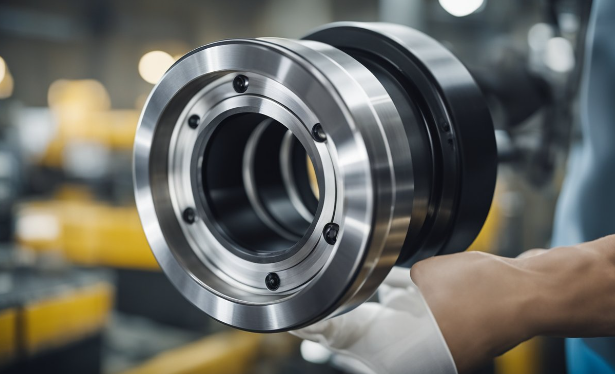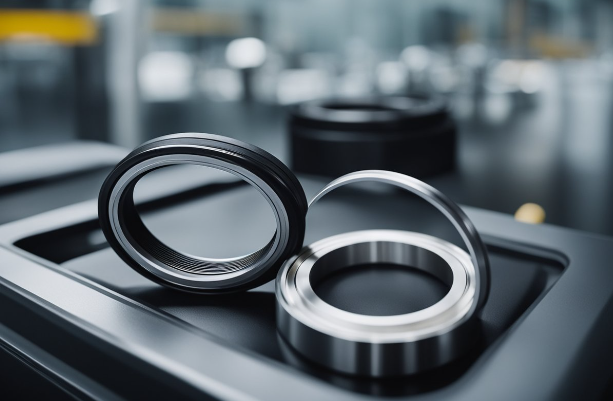PU Hydraulic Piston Seal: Understanding Its Function and Importance
If you're looking for a reliable and efficient hydraulic piston seal for your industrial application, a polyurethane (PU) hydraulic piston seal might be the perfect solution for you. PU hydraulic piston seals are known for their excellent performance and durability, making them a popular choice among manufacturers and maintenance professionals.
PU hydraulic piston seals are designed to provide a tight and reliable seal between the piston and cylinder wall, which is essential for proper functioning of hydraulic systems. These seals are made from high-quality polyurethane material, which offers excellent resistance to wear, abrasion, and extrusion. PU seals are also highly resilient and can withstand high pressure and temperature conditions, making them ideal for use in a variety of industrial applications.
When it comes to selecting the right PU hydraulic piston seal for your application, there are several factors to consider, including design and material specifications, installation guidelines, and operational considerations. Proper maintenance and replacement procedures are also important to ensure the longevity and performance of your hydraulic system. In this article, we'll provide an overview of PU hydraulic piston seals and discuss some of the key factors to consider when selecting and maintaining these seals in your hydraulic system.
Key Takeaways
- PU hydraulic piston seals are a reliable and efficient choice for industrial applications that require a tight and reliable seal between the piston and cylinder wall.
- When selecting a PU hydraulic piston seal, it's important to consider design and material specifications, installation guidelines, and operational considerations.
- Proper maintenance and replacement procedures are essential to ensure the longevity and performance of your hydraulic system.
Overview of PU Hydraulic Piston Seals
If you're looking for a reliable and efficient hydraulic piston seal, a polyurethane (PU) seal might be the right choice for you. PU hydraulic piston seals are known for their excellent wear resistance, high-pressure resistance, and good sealing properties.
PU seals are made of a thermoplastic polyurethane material, which is a type of elastomer that can be molded into various shapes and sizes. They are designed to fit snugly around the piston rod of a hydraulic cylinder and prevent hydraulic fluid from leaking outside of the cylinder during operation.
One of the key advantages of PU hydraulic piston seals is their ability to maintain a thin layer of lubrication on the piston rod. This not only helps prevent corrosion but also lubricates other important parts of your cylinder. PU seals are also resistant to abrasion, which means they can withstand the wear and tear of daily use without losing their sealing properties.
Another advantage of PU hydraulic piston seals is their versatility. They can be used in a wide range of applications, from light-duty to heavy-duty hydraulic cylinders. They can also be used in both single-acting and double-acting cylinders, depending on your specific needs.
In terms of maintenance, PU hydraulic piston seals are relatively easy to replace. They can be removed and replaced without having to disassemble the entire cylinder, which can save you time and money.
Overall, if you're looking for a reliable and durable hydraulic piston seal, a PU seal might be the right choice for you. Its excellent wear resistance, high-pressure resistance, good sealing properties, and versatility make it a popular choice for many hydraulic applications.
Design and Material Specifications

Material Properties
When it comes to designing hydraulic piston seals, the material properties play a crucial role in determining the overall performance of the seal. The material used must be able to withstand high pressures and temperatures, as well as resist wear and tear. In addition, the material must be compatible with the hydraulic fluid used in the system.
Common materials used in hydraulic piston seals include polyurethane (PU), nitrile rubber (NBR), and fluoroelastomers (FKM). PU is a popular choice due to its excellent resistance to wear and tear, high elasticity, and ability to withstand high pressures. NBR is also a good choice for low-pressure applications due to its affordability and good resistance to hydraulic fluids. FKM is used in applications where high temperatures and aggressive chemicals are present.
Seal Profiles
The design of the seal profile is also critical in ensuring the proper functioning of the hydraulic piston seal. The seal profile must be able to maintain sealing contact with the cylinder bore while allowing the piston to move smoothly.
There are several types of seal profiles available, including lip seals, V-ring seals, and U-cup seals. Lip seals are commonly used in low-pressure applications due to their simple design and low cost. V-ring seals are used in applications where the piston is exposed to high pressures and temperatures, as they provide excellent sealing performance and can withstand high pressure differentials. U-cup seals are designed for use in both high and low-pressure applications, and are commonly used in hydraulic cylinders due to their ability to provide effective sealing even at high speeds.
In conclusion, the design and material specifications of hydraulic piston seals are critical in ensuring the proper functioning of hydraulic systems. By selecting the appropriate material and seal profile, you can ensure that your hydraulic piston seals will provide reliable and long-lasting performance.
Installation Guidelines
Installing PU hydraulic piston seals can be a tricky process, but with the right tools and techniques, it can be done easily and efficiently. Here are some guidelines to follow:
Cleanliness is Key
Before installing the piston seal, ensure that the piston, cylinder, and all other components are clean and free of debris. Any dirt or particles can compromise the seal's functionality, leading to leaks or other issues. Use a lint-free cloth to clean the seal and installation tools thoroughly. This is especially important for high-pressure hydraulic seals, where even minor impurities can have significant consequences.
Choose the Right Tools
Make sure you have the right tools and equipment for the job. A piston seal installer tool can help ensure that the seal is installed correctly and evenly. A seal pick can be used to remove the old seal without damaging the piston or cylinder. A seal lubricant can also be used to help ease the installation process and prevent damage to the seal.
Install the Seal Correctly
Always follow the manufacturer's guidelines for installation and replacement of hydraulic piston seals. PU piston seals are typically installed with the lip facing inward towards the hydraulic fluid. Be sure to use the correct size seal for your piston and cylinder. A seal that is too small can lead to leaks, while a seal that is too large can cause damage to the piston or cylinder.
Test the Seal
After installation, test the seal for leaks by applying hydraulic pressure to the system. Check for any signs of leakage around the piston or cylinder. If there are no leaks, the seal has been installed correctly.
By following these guidelines, you can ensure that your PU hydraulic piston seal is installed correctly and will provide reliable performance for years to come.
Operational Considerations
Temperature Ranges
When selecting a PU hydraulic piston seal, it is important to consider the temperature range in which it will be operating. PU hydraulic piston seals are designed to operate within a specific temperature range, and operating outside of this range can result in seal failure.
Typically, the operating temperature range for PU hydraulic piston seals is between -40°C and 100°C. However, this can vary depending on the specific seal material and application. It is important to consult the manufacturer's specifications to ensure that the seal is suitable for your application's temperature requirements.
Pressure Limits
PU hydraulic piston seals are designed to withstand a certain amount of pressure, and exceeding this pressure limit can cause seal failure. When selecting a PU hydraulic piston seal, it is important to ensure that it is rated for the maximum pressure that your application will be subjected to.
The pressure limit for PU hydraulic piston seals varies depending on the specific seal material and application. Typically, PU hydraulic piston seals can withstand pressures up to 400 bar (5,800 psi). However, it is important to consult the manufacturer's specifications to ensure that the seal is suitable for your application's pressure requirements.
In summary, when selecting a PU hydraulic piston seal, it is important to consider both the temperature range and pressure limits of your application. Consult the manufacturer's specifications to ensure that the seal is suitable for your specific requirements.
Maintenance and Replacement Procedures
Maintaining and replacing your PU hydraulic piston seal is crucial for the optimal performance of your hydraulic system. In this section, we will provide you with some guidelines on how to properly maintain and replace your piston seal.
Maintenance Procedures
Regular maintenance of your PU hydraulic piston seal can extend its lifespan and prevent costly repairs. Here are some essential maintenance procedures:
- Inspect the seal regularly: Regular inspection of the seal can help you identify any signs of wear or damage. Check for cracks, tears, or any other deformities that could compromise the seal's integrity.
- Clean the seal: Regularly clean the seal to remove any dirt or debris that could cause damage to the seal. Use a soft cloth or brush to clean the seal gently.
- Check the hydraulic fluid: Check the hydraulic fluid regularly to ensure that it is at the correct level and is free from contaminants. Contaminated hydraulic fluid can cause damage to the seal and other hydraulic components.
Replacement Procedures
Replacing a damaged or worn-out PU hydraulic piston seal is essential to maintain the optimal performance of your hydraulic system. Here are some replacement procedures:
- Identify the correct replacement seal: Before replacing the seal, make sure to identify the correct replacement seal. Check the manufacturer's specifications or consult with a hydraulic expert to ensure that you are using the correct replacement seal.
- Remove the old seal: To remove the old seal, you will need to disassemble the hydraulic cylinder. Carefully remove the old seal, making sure not to damage the cylinder or piston rod.
- Install the new seal: Once you have removed the old seal, carefully install the new seal. Make sure that the seal is properly aligned and seated in the cylinder. Lubricate the seal with hydraulic fluid before reassembling the cylinder.
By following these maintenance and replacement procedures, you can ensure that your PU hydraulic piston seal operates at peak performance and extends its lifespan.
Industry Applications
PU hydraulic piston seals are widely used in various industrial applications due to their excellent wear resistance, high-pressure resistance, and good sealing properties. They are used in a variety of hydraulic systems, including heavy-duty construction equipment, industrial machinery, and agricultural equipment.
One of the primary applications of PU hydraulic piston seals is in the construction industry. They are used in heavy-duty equipment such as excavators, bulldozers, and backhoes. These machines require hydraulic systems that can withstand high pressure and heavy loads. PU seals are ideal for these applications because of their ability to maintain their sealing performance even under extreme conditions.
Another industry that relies heavily on PU hydraulic piston seals is the manufacturing industry. They are used in a wide range of industrial machinery, including hydraulic presses, injection molding machines, and CNC machines. These machines require hydraulic systems that can operate at high pressures and temperatures, and PU seals are well-suited for these applications.
PU hydraulic piston seals are also commonly used in agricultural equipment such as tractors, harvesters, and sprayers. These machines require hydraulic systems that can operate in harsh outdoor environments and withstand exposure to dust, dirt, and other contaminants. PU seals are well-suited for these applications because of their ability to maintain their sealing performance even in dirty and dusty environments.
In summary, PU hydraulic piston seals are widely used in various industrial applications due to their excellent wear resistance, high-pressure resistance, and good sealing properties. They are used in heavy-duty construction equipment, industrial machinery, and agricultural equipment, among other applications.

